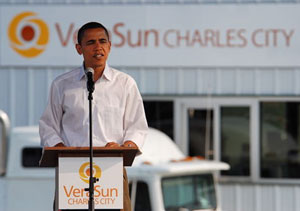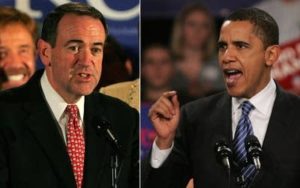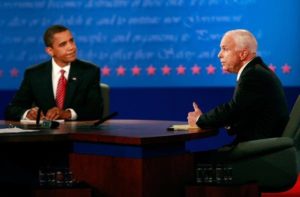Obama Hitches a Ride on Alternative Energy Train
Ethanol helped fuel conversations and conversions among candidates in the 2008 presidential race starting back in 2007 when the upstart Senator from Illinois showed up at an ethanol plant.
 While former First Lady Hillary Clinton had the name recognition, by mid-2007 Sen. Barack Obama quickly saw the support for ethanol and hitched a ride on the alternative energy train, calling for a National Low Carbon Fuel Standard (NLCFS) similar to one Governor Arnold Schwarzenegger has just created in California. “It will take a grassroots effort to make America greener and end the tyranny of oil,” said Obama.
While former First Lady Hillary Clinton had the name recognition, by mid-2007 Sen. Barack Obama quickly saw the support for ethanol and hitched a ride on the alternative energy train, calling for a National Low Carbon Fuel Standard (NLCFS) similar to one Governor Arnold Schwarzenegger has just created in California. “It will take a grassroots effort to make America greener and end the tyranny of oil,” said Obama.
During a five day tour of Iowa in August, Obama made a stop in Charles City to help cut the ribbon at the grand opening of the third ethanol plant for VeraSun Energy.
Obama said there that ethanol “ultimately helps our national security because right now we’re sending billions of dollars to some of the most hostile nations on earth, and makes it more difficult for us to shape a foreign policy that is intelligent and is creating security for the long term.”
At that time, VeraSun was nearly at its zenith with the Charles City plant bringing the company’s total production capacity to 450 million gallons per year with four facilities in operation and another 550 million gallons of capacity under construction at five different sites. In addition to the Linden facility, VeraSun has operating plants in Aurora, South Dakota and Fort Dodge and Charles City, Iowa. Construction is also underway at Hartley, Iowa; Welcome, Minnesota; and Reynolds, Indiana.
Being new in Congress and from a traditional Midwestern corn growing state, Obama did not have the anti-ethanol history that some of the other candidates had. Senators Hillary Clinton (D-NY) and John McCain (R-AZ) had shown consistent opposition to renewable fuels until both experienced a “conversion” in 2006, according to the Washington Post. McCain had even voted against the Energy Policy Act of 2005, the Environmental Effects Caused by Ethanol Amendment and the Energy Omnibus Bill, and during his presidential bid in 2000 he completely ignored the state of Iowa.
Senator Clinton stated in 2002 that “there is no sound public policy reason for mandating the use of ethanol” but the Post said when she reversed herself she “endorsed even bigger ethanol incentives than she previously voted against. Now running for president, Clinton is promoting a $50 billion strategic energy fund, laden with more ethanol perks.” Her campaign website laid out her views on alternative energy:
Hillary has a bold and comprehensive plan to address America’s energy and environmental challenges that will establish a green, efficient economy and create as many as five million new jobs. Hillary’s plan to promote energy independence, address global warming, and transform our economy includes: Aggressive action to transition our economy toward renewable energy sources, with renewables generating 25 percent of electricity by 2025 and with 60 billion gallons of home-grown biofuels available for cars and trucks by 2030
From John McCain’s campaign site:
Alcohol fuels made from corn, sugar, switch grass and many other sources, fuel cells, biodiesel derived from waste products, natural gas, and other technologies are all promising and available alternatives to oil. I won’t support subsidizing every alternative or tariffs that restrict the healthy competition that stimulates innovation and lower costs. But I’ll encourage the development of infrastructure and market growth necessary for these products to compete, and let consumers choose the winners. I’ve never known an American entrepreneur worthy of the name who wouldn’t rather compete for sales than subsidies.
 Iowa Picks Obama and Huckabee
Iowa Picks Obama and Huckabee
Starting off the race to be the nominee in January, Barack Obama and former Arkansas Governor Mike Huckabee were the top vote-getters in the Democratic and Republican caucuses in the Hawkeye State. Both offered support for renewable fuels on their campaign websites.
Obama promised to:
– Invest federal resources, including tax incentives, cash prizes and government contracts into developing the most promising technologies with the goal of getting the first two billion gallons of cellulosic ethanol into the system by 2013.
– Expand Locally-Owned Biofuel Refineries: Less than 10 percent of new ethanol production today is from farmer-owned refineries. New ethanol refineries help jumpstart rural economies. Obama will create a number of incentives for local communities to invest in their biofuels refineries.
– Establish a National Low Carbon Fuel Standard: Barack Obama will establish a National Low Carbon Fuel Standard to speed the introduction of low-carbon non-petroleum fuels. The standard requires fuels suppliers to reduce the carbon their fuel emits by ten percent by 2020.
– Increase Renewable Fuel Standard: Obama will require 36 billion gallons of renewable fuels to be included in the fuel supply by 2022 and will increase that to at least 60 billion gallons of advanced biofuels like cellulosic ethanol by 2030.
Huckabee’s commitments were less specific:
We have to explore, we have to conserve, and we have to pursue all avenues of alternative energy: nuclear, wind, solar, hydrogen, clean coal, biodiesel, and biomass. Some will come from our farms and some will come from our laboratories. Dwindling supplies and increasing demand from newly-industrialized countries of fossil fuels are driving up prices. These price increases will facilitate innovation and the opportunity for independence. We will remove red tape that slows innovation. We will set aside a federal research and development budget that will be matched by the private sector to seek the best new products in alternative fuels. Our free market will sort out what makes the most sense economically and will reward consumer preferences.
In the end, it was John McCain who faced off with Barack Obama, and alternative fuels became an issue in the campaign.
 Biofuels on the Debate Stage
Biofuels on the Debate Stage
Vice Presidential candidates Joe Biden and Sarah Palin held a fiery debate during the campaign in which energy policy was brought up several times. Biden claimed the upper hand in promoting renewable energy.
“John McCain has voted 20 times in the last decade-and-a-half against funding alternative energy sources, clean energy sources, wind, solar, biofuels, the way in which we can stop the greenhouse gases from emitting,” said Biden, answering a question about climate change. “Barack Obama believes by investing in clean coal and safe nuclear, we can not only create jobs in wind and solar here in the United States, we can export it.”
Palin argued that “John McCain is right there with an “all of the above” approach to deal with climate change impacts…We’ve got to become energy independent for that reason…it’s all the more reason that we have an “all of the above” approach, tapping into alternative sources of energy and conserving fuel, conserving our petroleum products and our hydrocarbons so that we can clean up this planet and deal with climate change.”
 There were three presidential debates between Obama and McCain, the first of which was held before the vice presidential debate where the issue of McCain’s votes against alternative energy were brought up multiple times by Obama saying, “Over 26 years, Senator McCain voted 23 times against alternative energy, like solar, and wind, and biodiesel, alternative fuels.”
There were three presidential debates between Obama and McCain, the first of which was held before the vice presidential debate where the issue of McCain’s votes against alternative energy were brought up multiple times by Obama saying, “Over 26 years, Senator McCain voted 23 times against alternative energy, like solar, and wind, and biodiesel, alternative fuels.”
Obama’s claim about McCain’s 23 votes against alternative fuels is partially supported by PolitiFact, which notes McCain’s votes against renewable energy amendments in 2005 but highlights his support for a 1992 energy bill promoting alternative fuels.
In the second debate, in response to a question on government spending, McCain specifically mentioned ethanol, hitting on a sensitive topic for the industry. “First of all, by the way, I’d eliminate ethanol subsidies. I oppose ethanol subsidies,” McCain said.
In the third debate, McCain doubled down on ethanol subsidies. “I oppose subsidies for ethanol because I thought it distorted the market and created inflation; Senator Obama supported those subsidies. I would eliminate the tariff on imported sugarcane-based ethanol from Brazil.”
At that time, the primary ethanol subsidy offered by the federal government was a tax incentive called the Volumetric Ethanol Excise Tax Credit (VEETC), which was implemented in 2005 and lasted until 2011. Commonly referred to as the “blender’s credit,” it offered ethanol blenders a tax credit of 45 cents for every gallon of pure ethanol blended with gasoline. To make sure the tax credit would benefit only domestic ethanol producers, a 54 cent per gallon tariff was placed on ethanol imported from Brazil.
Obama Declares Victory as VeraSun Declares Bankruptcy
Obama’s visit to VeraSun in 2007 may have helped his campaign, but it did nothing to keep the company from falling into bankruptcy in November 2008 with 16 production facilities in eight states.
“The filing was precipitated by a series of events that led to a contraction in VeraSun’s liquidity, impairing its ability to operate its business and invest in production facilities. The Company suffered significant losses in the third quarter of 2008 from a dramatic spike in its corn costs, reflecting in part costs attributable to its corn procurement and hedging arrangements, and historically unfavorable margins. Beginning in the third quarter, worsening capital market conditions and a tightening of trade credit resulted in severe constraints on the Company’s liquidity position.”
VeraSun ended up selling seven of the plants to Valero Energy Corporation, and the rest to other companies in 2009.
Just two days after VeraSun declared bankruptcy, Barack Obama declared victory in the 2008 presidential election. Obama granted an interview to farm brodcaster Stewart Doan with Agri-Pulse who quizzed him on a number of agricultural issues, including biofuels.
“I’ve been a strong supporter of biofuels in the past and a Renewable Fuel Standard,” Obama said. “What I do believe though is, given the pressure that we’re seeing on food crops and how that’s affecting feed prices, I do think that it is important for us to recognize that we need to move into things like switchgrass and cellulosic ethanol and we need to work with farmers to figure out how can we produce ethanol from non-food sources that would allow farmers to increase their incomes, would continue to improve rural economies, would help us with our dependence on foreign oil and would reduce climate change, but would not put so much pressure on feed prices.”
By the end of the year, President-elect Obama had announced the majority of his cabinet, including picks that would move the renewable fuels agenda forward.
Physicist and Nobel laureate Dr. Steven Chu, chosen as Secretary of Energy, was a vocal advocate for renewable energy and shifting away from fossil fuels to combat climate change. Lisa Jackson, a chemical engineer with the New Jersey Department of Environmental Protection, was picked as EPA Administrator. For Secretary of Agriculture, Obama chose former Iowa Governor and momentary presidential candidate Tom Vilsack, who was already a strong ethanol supporter and who ultimately became one of the industry’s greatest champions, serving in both Obama administrations and the Biden Administration.Vilsack was also already an advocate for cellulosic ethanol. “Iowa is one of the nation’s leading producers of corn-based ethanol, and many people in my state have an economic stake in the expanded use of corn-based ethanol. But the reality is that corn-based ethanol will never be enough to reach our goals … the only way we can produce enough domestically is if we greatly improve the technology used to produce cellulosic ethanol.”
